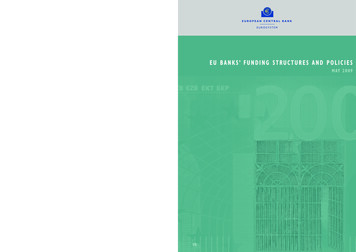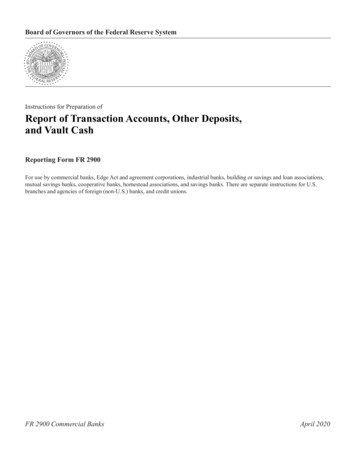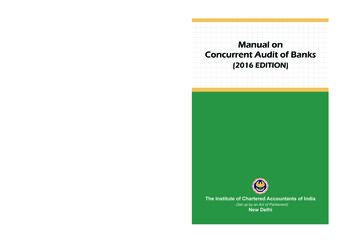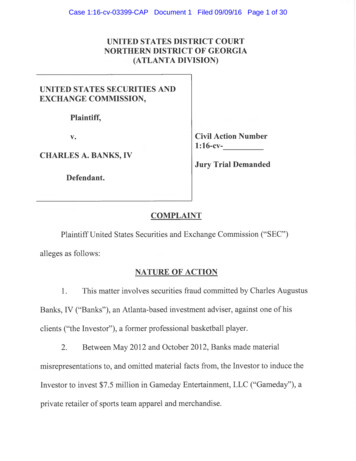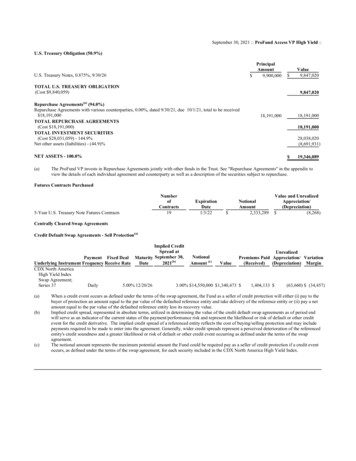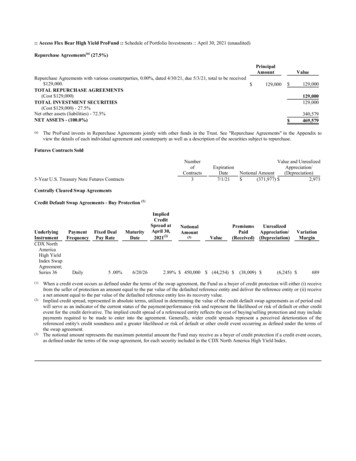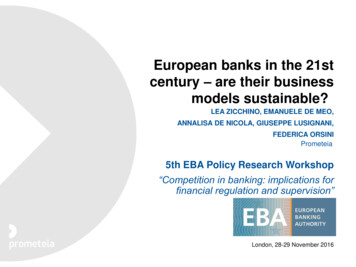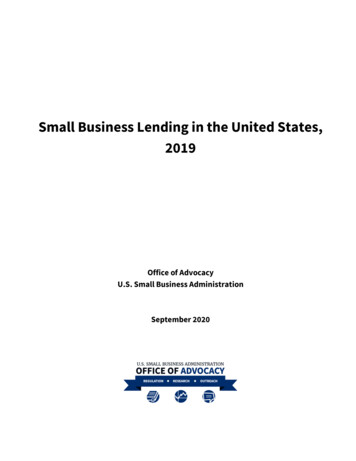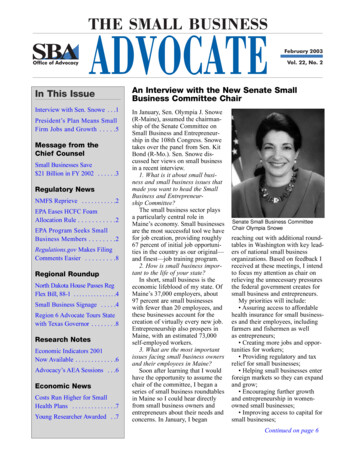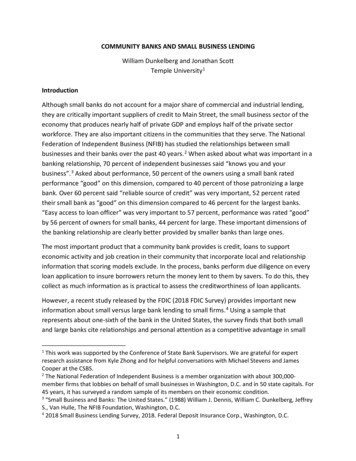
Transcription
COMMUNITY BANKS AND SMALL BUSINESS LENDINGWilliam Dunkelberg and Jonathan ScottTemple University 1IntroductionAlthough small banks do not account for a major share of commercial and industrial lending,they are critically important suppliers of credit to Main Street, the small business sector of theeconomy that produces nearly half of private GDP and employs half of the private sectorworkforce. They are also important citizens in the communities that they serve. The NationalFederation of Independent Business (NFIB) has studied the relationships between smallbusinesses and their banks over the past 40 years. 2 When asked about what was important in abanking relationship, 70 percent of independent businesses said “knows you and yourbusiness”. 3 Asked about performance, 50 percent of the owners using a small bank ratedperformance “good” on this dimension, compared to 40 percent of those patronizing a largebank. Over 60 percent said “reliable source of credit” was very important, 52 percent ratedtheir small bank as “good” on this dimension compared to 46 percent for the largest banks.“Easy access to loan officer” was very important to 57 percent, performance was rated “good”by 56 percent of owners for small banks, 44 percent for large. These important dimensions ofthe banking relationship are clearly better provided by smaller banks than large ones.The most important product that a community bank provides is credit, loans to supporteconomic activity and job creation in their community that incorporate local and relationshipinformation that scoring models exclude. In the process, banks perform due diligence on everyloan application to insure borrowers return the money lent to them by savers. To do this, theycollect as much information as is practical to assess the creditworthiness of loan applicants.However, a recent study released by the FDIC (2018 FDIC Survey) provides important newinformation about small versus large bank lending to small firms. 4 Using a sample thatrepresents about one-sixth of the bank in the United States, the survey finds that both smalland large banks cite relationships and personal attention as a competitive advantage in smallThis work was supported by the Conference of State Bank Supervisors. We are grateful for expertresearch assistance from Kyle Zhong and for helpful conversations with Michael Stevens and JamesCooper at the CSBS.2The National Federation of Independent Business is a member organization with about 300,000member firms that lobbies on behalf of small businesses in Washington, D.C. and in 50 state capitals. For45 years, it has surveyed a random sample of its members on their economic condition.3“Small Business and Banks: The United States.” (1988) William J. Dennis, William C. Dunkelberg, JeffreyS., Van Hulle, The NFIB Foundation, Washington, D.C.42018 Small Business Lending Survey, 2018. Federal Deposit Insurance Corp., Washington, D.C.11
business lending and are willing to grant exceptions in underwriting policies based on existingloan and depositor relationships. The differences in relationship lending lie in the focus, wheresmall banks tend to focus on community involvement and personal attention, while large banksfocus on professional referrals. Both small and large banks use the same underwriting criteria,but large banks are more likely to use business credit scores and more likely to offer businesscredit cards and standardized products. Finally, small banks have a speed advantage inapproving loans.The 2018 National Survey of Community Banks provides insight into the role of communitybanks and small business lending (almost 96 percent of the respondents report making smallbusiness loans). Small banks report the type of information they use in making a small businessloan, which provides additional insight beyond the 2018 FDIC Survey into the importance ofhard information such as financial statements and soft information such as the lendingrelationship and length of the relationship for underwriting loans. The banks also report onancillary service offerings to small firms that again can be either a hard service such as depositservices or a soft service such as strategic or operational advice, which provides insight into thedepth of relationships small banks have with small firms. Finally, current and futurecompetition for small business loans is also reported along with what terms are adjusted toother lenders in the market, which gives some insight into changes in the competitivelandscape and how small banks are dealing with competition in their home market.Small Business Loan UnderwritingThis survey provides a window into the type of information small banks use when making smallbusiness loans wheresmall banks are said toChart 1have a strong emphasis onFactors Used to Underwrite Small Firm Loansrelationship lending. Chartpercent Reporting Important Very Important1 shows the various pieces70%60%of information collected by50%community banks ranked40%by the percent30%characterizing the20%10%information sources as0%“very important.” Whilethe importance ofrelationships Notquantifiable) has beenemphasized in theliterature for small2
business lending and community banks, the top two measurable factors are financialstatements (reported by 64 percent of the banks) and business collateral (reported by 42percent). This reliance on hard information is not say that soft information is not important,because bank examiners will payChart 2close attention to traditionalAdditional Services Offered to Smallmetrics for credit underwriting. AnBusinesseshistorical or current lendingpercent Reporting Important Veryrelationship is cited by 30 percentImportantof the respondents as a factor inunderwriting a loan, along with 21Deposit servicespercent reporting that the futureCash management servicespotential relationship isLong-term strategic adviceconsidered and 17 percent theOther general management adviceOperational advicelength of the relationship. The onlyWealth management advicefactor that had any associationManagement succession adviceProduct Developmentwith bank size was business creditConnections to customers/suppliersscore and SBA guarantees, where0%20%40%60%80%large banks more frequentlyreported these factors as important in underwriting small firm loans.Ancillary Service OfferingsBanks offer other important services, often tied into a loan agreement, to gain or keep valuedcustomers and deepen their relationship. For many businesses, community banks are animportant source of management advice and market information. The 2018 National Surveyasks the respondents to report on nine additional services beyond lending and the results areshown in Chart 2. Deposit services are most frequently reported (92 percent) followed by cashmanagement services (37 percent). Many other of the soft services are reported lessfrequently. Bank size is strongly associated with some of these services. Larger banks (over 800 billion) more frequently offer cash, strategic management advice, wealth managementadvice, and other general management advice. Thus, it appears that some scale is required forsmall banks to offer a number of these soft services to their small business customers, becauseproviding these often requires the acquisition of high fixed cost assets (e.g. a lawyer orinvestment specialist) that cannot be spread over a large customer base.Competition for Small Business LoansSmall business lending does not occur in a vacuum. Community banks most frequently report(54 percent) other community banks (assets less than 1 billion) as their primary competitor.The next most frequently reported competitor is mid-size banks ( 1 to 10 billion) at 28percent. If a broader definition of community banks is used that includes banks with assets up3100%
to 10 billion, then the primary competition for 82 percent of the respondents is othercommunity banks.Chart 3Urban versus ruralCompetitors for Small Business Loanslocation plays apredictable role inSmall bankswhether a smallMid-sizecommunity bank orRegionalmid-sized communityCredit Unionsbank is viewed asDo not offerprimary competition:Large regionalOther, e.g. mortgage bankin non-urban areas itFintechis the small bank,01020304050while in urban areas itis the mid-sizeFutureCurrentcommunity bank.60Looking ahead, small banks see a notable shift in the competitive landscape. Only 67 percent ofthe respondents report that competition will come from their peers. Increased competition isreported from regional banks, 7 percent to 10 percent, and credit unions, 6 percent to 10percent. The biggest change is with fintech, where no small bank sees fintech as a primarycompetitor today, but 7 percent do in the future. Location is associated with the reporting offuture competition, with community banks in MSAs more likely to report fintech and other nondepository institutions as their future primary competitor, while those in rural areas are morelikely to report credit unions and large banks as future primary competitors.Loan Terms and Response to CompetitionCommunity banks operate in competitive markets and even long-time customers will try tonegotiate better terms, especially later in a business cycle. Sixty-three percent of the banks inthe 2018 National Survey reported reducing terms “half the time” or “Usually/Always” inresponse to competition to make a loan transaction. Fifty-one percent reported that thepressure came from banks headquartered in their market. Although competition is a headacheto the management of a community (or any) bank, it is essential to the health of the bankingindustry and the economy.A number of possible terms can be adjusted in negotiations to close a loan deal in a competitivemarket. Only 5 percent reported having to make adjustments “usually” or “always” and 5percent reported making no adjustments in 2017. Thirty-three percent reported “rarely” or“never” making adjustments in order to close a loan. The most frequently adjusted term, no4
surprise, is the interest rate charged, followed closely by loan fees. Collateral requirements (thesecond way out of a loan) were rarely altered to close a loan.RarelyNever43 %75 %91 %53 %81 %83 %TERMLower ratesExtend maturityReduce collateral requiredLower feesAllowing more leverageFewer covenantsHalf theTime37 %18 %5%31 %14 %11 %UsuallyAlways20 %5%3%15 %4%5%Larger community banks are more flexible on loan terms. The percent “usually” or “always”adjusting one or more loan terms to close a loan rises with bank size, from 5 percent for thesmallest (under 200 million in assets) to 12 percent for the largest banks (Table 1). Looking atparticular terms, the percent willing to adjust collateral “usually” or “always” rises from 2percent for the smallest to 7 percent for the largest (Table 2). Fee reductions are also morefrequent among the larger banks (Table 3). Covenant reductions (Table 4) show the samepattern. It is not clear what causes these bank size differences. No strong association is presentfor loan term adjustments and urban versus rural location. Larger banks tend to be in moreurbanized markets and more likely to see more potential competitors, heightening theirwillingness to negotiate.Table 1: COMPETITIVE LOAN TERM ADJUSTMENTSBANK SIZE Usual/AlwaysRarely/NeverUnder 100m 100m 200m 200m 400m 400m 800m 800m All Banks584490791118312817%86 %All BanksTable 2: ADJUST COLLATERAL REQUIREMENTSBANK SIZE Usual/AlwaysRarely/NeverUnder 100m 100m 200m 200m 400m 400m 800m 800m 28429029148378153%92 %
Table 3: LOWER FEESBANK SIZE Usual/AlwaysHalf the TimeUnder 100m 100m 200m 200m 400m 400m 800m 800m 10111430144021401636All Banks15 %32 %Table 4: FEWER COVENANTSBANK SIZE Under 100m 100m 200m 200m 400m 400m 800m 800m All BanksUsual/Always244675%Half the Time8812131611 %ConclusionRelationship lending is a comparative advantage for community banks. Their loan committeesknow the local market, often know the loan applicants, and possess information that is notused by branches of larger competitors where loan decisions are centralized, often based onpoint scoring models that cannot incorporate loan committee knowledge. This is an importantniche in financial markets that is filled by a decreasing number of community banks, a concernfor small business. All banks rely on roughly the same hard data, but only small banks are bettersuited to incorporate relationship information in the credit decision process.Small banks can deepen their relationship with small firms through offering ancillary productsand services. Deposit services are most frequently offered by community banks but fewercommunity banks offer soft services such as advice on strategy, product development,operations, and management succession. Larger community banks are more likely to offerthese soft services because they operate in larger markets that offer enough potentialcustomers for these services to economically amortize the higher costs of providing them.Community banks generally view other small banks as the primary competition for small loansto businesses but in urban areas it is the larger community banks (between 1 and 10 billion in6
assets), while in rural areas it is the smaller community banks (under 1 billion). Looking ahead,community banks see fintech firms becoming more important as primary competitors for smallfirm loans, but this threat is more frequently seen by banks in urban areas.Longer term, internet-based services will reduce the need for brick and mortar locations thatare typically used by community banks. However, technology deployed over the internet willmake it easier for community banks to compete effectively with larger banks, providingincreasing convenience, safety and financial management tools comparable to even the largestbanks. Further deregulation will also reduce the regressive compliance burden faced bycommunity banks, allowing them to compete more effectively and profitably in the future.7
business lending and are willing to grant exceptions in underwriting policies based on existing loan and depositor relationships. The differences in relationship lending lie in the focus, where small banks tend to focus on community involvement and personal attention, while large banks focus on professi onal referrals.
